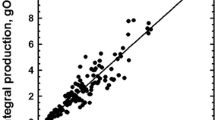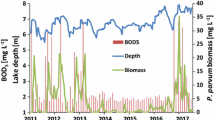Abstract
Community respiration in tropical Lake Xolotlán, Nicaragua, was assessed seasonally and during diurnal cycles, via oxygen consumption in bottle enclosures. Results were analysed in relation to phytoplankton biomass, mixing depth, depth of photic zone and phytoplankton production. A great part of community respiration was associated with the heterotrophic activity of the phytoplankton biomass or its degradation by bacteria and 80% of the variability in oxygen consumption was explained by the variation of chlorophyll-a. Specific rate of respiration was 1.5 mg O2 mg Chla-1 h-1 during diurnal cycles, which corresponded to less than 5% of the specific rate at optimum depth of production. Still, diurnal water column respiratory losses were always of the same magnitude as the total photosynthetic gains in the photic zone, since the mixing depth exceeded the depth of the photic zone. Total column net growth was zero at a ratio between depth of photic zone and mixing depth of 0.19. Water level variations however altered the mixing depth and affected this ratio and net growth. As a consequence, the phytoplankton biomass either increased or decreased until the ratio was re-established through changes of the photic zone depth, which was governed by the phytoplankton biomass itself through the chlorophyll-a light attenuation.
Similar content being viewed by others
References
Ahlgren, I., C. Chacón, R. García, I. Mairena, K. Rivas & A. Zelaya, 1997. Sediment microbial activity in temperate and tropical lakes, a comparison between Swedish and Nicaragua lakes. Verh. int. Ver. Limnol. 26: 429–434.
Alpine, A. E. & J. E. Cloern, 1988. Phytoplankton growth rates in light-limited environments, San Fransisco Bay. Mar. Ecol. Prog.
Bannister, T. T., 1974. A general theory of steady state phytoplankton growth in nutrient-saturated mixed layer. Limnol. Oceanogr. 19: 13–30.
Cloern, L. E., 1987. Turbidity as a control on phytoplankton biomass and productivity in estuaries. Cont. Shelf Res. 7: 1367–1381.
Cole, J. J., N. F. Caraco & B. L. Peierls, 1992. Can phytoplankton maintain a positive carbon balance in turbid, freshwater, tidalestuary? Limnol. Oceanogr. 37: 1608–1617.
Erikson, R., E. Hooker & M. Mejia, 1991. Underwater light penetration, phytoplankton biomass and photosynthetic activity in Lake Xolotlán. Hydrobiol. Bull. 25: 137–144.
Erikson, R., M. Pum, K. Vammen, A. Cruz, M. Ruiz & H. Zamora, 1997. Nutrient availability and the stability of phytoplankton biomass and production in Lake Xolotlán (Nicaragua). Limnologica 27: 157–164.
Erikson, R., E. Hooker, M. Mejia, A. Zelaya & K. Vammen, 1998a. Optimal conditions for primary production in a polymictic tropical lake (Lake Xolotlán, Nicaragua). Hydrobiologia 382: 1–16.
Erikson, R., K. Vammen, A. Zelaya & R. T. Bell, 1998b. Distribution and dynamics of bacterioplankton production in a polymictic tropical lake (Lake Xolotlán, Nicaragua). Hydrobiologia 382: 27–39.
Foy, R. H., C. E. Gibson & R. V. Smith, 1976. The influence of day length, light intensity and temperature on the growth rate of planktonic blue-green algae. Br. phycol. J. 11: 151–163.
Fuente, J. L., 1986. Red solar y la estación Vadstena, Nicaragua. Reporte Técnico-Investigativo No 04/86, UCA, Managua.
Ganf, G. G., 1974. Rates of oxygen uptake by planktonic community of a shallow equatorial lake (Lake George, Uganda). Oecologia (Berl.) 15: 17–34.
Ganf, G. G. & A. B. Viner, 1973. Ecological stability in a shallow equatorial lake (Lake George, Uganda). Proc. r. Soc. Lond. B. 184: 321–346.
Grobbelaar, J. U., 1985. Phytoplankton productivity in turbid waters. J. Plankton Res. 5: 653–663.
Harris, G. P., 1973. Diel and annual cycles of net plankton photosynthesis in Lake Ontario. J. Fish. Res. Bd Can. 30: 1779–1787.
Harris, G. P., 1978. Photosynthesis, production and growth: The physiological ecology of phytoplankton. Ergebn. Limnol. 10: 1–171.
Hooker, E. & S. Hernandez, 1991. Phytoplankton biomass in Lake Xolotlán (Managua): Its seasonal and horizontal distribution. Hydrobiol. Bull. 25: 125–131.
IRENA, 1982. Informica basica sobre el Lago de Managua (Xolotlán): Tallér international de salvamento y aprovechamiento integral del Lagode Managua. IRENA, Managua.
Jensen, M. L., K. Sand-Jensen, S. Marcher & M. Hansen, 1990. Plankton community respiration along a nutrient gradient in a shallow Danish estuary. Mar. Ecol. Prog. Ser. 61: 75–85.
Lacayo, M., 1991. Physical and chemical features of Lake Xolotlán (Managua). Hydrobiol. Bull. 25: 111–116.
Langdon, C., 1988. On the causes of interspecific differences in growth-irradiance relationship for phytoplankton. 2. A general review. J.Plankton Res. 10: 1291–1312.
Larsson, U. & A. Hagström, 1979. Phytoplankton exudate release as anenergy source for the growth of pelagic bacteria. Mar. Biol. 52: 199–206.
Larsson, U. & A. Hagström, 1982. Fractionated phytoplankton primary production, exudates release and bacterial production in a Baltic eutrophication gradient. Mar. Ecol. 67: 57–70.
Lemoalle, J., A. Adeniji, P. Compere, G. G. Ganf, J. Melack & J. F. Talling, 1981. Phytoplankton. In J. J. Symmoens, M. Burgis & J. J. Gaudet (eds), The Eecology of and Utilization of African Inland Waters. UNEP, Nairobi: 37–50.
Lewis, W. M. Jr, 1988. Primary production in the Orinoco River. Ecology 69: 679–692.
Mangas, E. I. & H. García, 1991. Seasonal fluctuation of zooplankton biomass in Lake Xolotlán (Managua). Hydrobiol. Bull. 25: 157–162.
Melack, J. M., 1979. Temporal variability of phytoplankton in tropical lakes. Oecologia 44: 1–7.
Montenegro, G. S., 1992. A note on the eolic action as an ecological factor upon Lake Xolotlán (Nicaragua). Verh. int. Ver. Limnol. 25: 894–896.
Padan, E., B. Raboy & M. Shilo, 1971. Endogenous dark respiration of the blue green alga Plectenema boryanum. J. Bact. 106: 45–50.
Raven, J. A. & S. M. Glidewell, 1975. Photosynthesis, respiration and growth in the shade alga Hydrodictyon africanum. Photosynthetica 9: 361–371.
Ryther, J. H., 1954. The ratio of photosynthesis to respiration in marineplanktonic algae and its effect upon measurement of productivity. Deep Sea Res. 2: 134–139.
Schwaerter, S., M. Søndergaard, B. Riemann & L. Møller Jensen, 1988. Respiration in eutrophic lakes: Contribution of bacterioplankton and bacterial growth yield. J. Plankton Res. 10: 551–531.
Sentzova, O. Y., K. A. Nitikina & M. V. Gusev, 1975. Oxygen exchange of the obligate phototrophic blue-green alga Anabaena variablis in darkness. Microbiologiya 4: 283–288.
Snedecor, G. W. & W. G. Cochran, 1980. Statistical methods. 7th edn. Iowa State University Press, Ames, Iowa, USA.
Steele, J. H., 1962. Environmental control of photosynthesis in the sea. Limnol. Oceanogr. 7: 137–150.
Sverdrup, H. V., 1953. On conditions for vernal blooming of phytoplankton. J. Cons. perm. int. Explor. Mer. 16: 287–295.
Talling, J. F., 1957a. Photosynthetic characteristics of some freshwater diatoms in relation to underwater radiation. New Phytol. 56: 29–48.
Talling, J. F., 1957b. The phytoplankton population as a compound photosynthetic system. New Phytol. 56: 133–149.
Talling, J. F., 1965. The photosynthetic activity of phytoplankton in East African lakes. Int. Rev. ges. Hydrobiol. 50: 1–32.
Talling, J. F., 1971. The underwater light climate as a controlling factor in production ecology of freshwater phytoplankton. Mitt. int. Ver. Limnol. 19: 100–124.
Vargas, M. H., K. Vammen, I. Mairena, A. Zelaya, L. Vanagas & C. Chacón, (1991): Estudios de la dispersion horizintal de bacterias fecales en el litoral sur del Lago Xolotlán. Taller de la limnolgia aplicada al Lago de Managua para su recuperacion y aprovechamiento. UNAN, Managua.
Wofsy, S. C., 1983. A simple model to predict extinction coeffi-cients and phytoplankton biomass in eutrophic waters. Limnol. Oceanogr. 28: 1144–1155.
Author information
Authors and Affiliations
Rights and permissions
About this article
Cite this article
Erikson, R. Algal respiration and the regulation of phytoplankton biomass in a polymictic tropical lake (Lake Xolotlán, Nicaragua). Hydrobiologia 382, 17–25 (1998). https://doi.org/10.1023/A:1003424802421
Issue Date:
DOI: https://doi.org/10.1023/A:1003424802421




